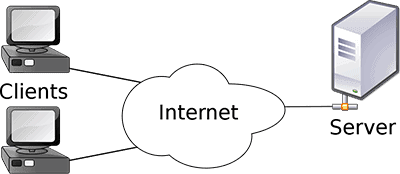CompTIA Network+ | Microsoft MTA Networking: Common Logical Network Topologies
[bs_icon name=”glyphicon glyphicon-chevron-right”] Peer to Peer – A peer to peer network is one in which lacks a dedicated server and every computer acts as both a client and a server. This is a good networking solution when there are 10 or less users that are in close proximity to each other. A peer to peer network can be a security nightmare, because the people setting permissions for shared resources will be users rather than administrators and the right people may not have access to the right resources. More importantly the wrong people may have access to the wrong resources, thus, this is only recommended in situations where security is not an issue. P2P file sharing networks work under a similar architecture, however, there are differences between them and the LAN networking architecture.
[bs_icon name=”glyphicon glyphicon-chevron-right”] Client/Server – This type of network is designed to support a large number of users and uses dedicated server/s to accomplish this. Clients log in to the server/s in order to run applications or obtain files. Security and permissions can be managed by 1 or more administrators which who set permissions to the servers’ resources. This type of network also allows for convenient backup services, reduces network traffic and provides a host of other services that come with the network operating system.

[bs_icon name=”glyphicon glyphicon-chevron-right”] VPN – A virtual private network is one that uses a public network (usually the Internet) to connect remote sites or users together. Companies use site to site VPN to support critical applications to connect offices to remote users. Instead of using a dedicated, real-world connection such as leased line, a VPN uses “virtual” connections routed through the Internet from the company’s private network to the remote site or employee.
[bs_icon name=”glyphicon glyphicon-chevron-right”] VLAN – A virtual LAN is a local area network with a definition that maps workstations on a basis other than geographic location (for example, by department, type of user, or primary application). The virtual LAN controller can change or add workstations and manage load-balancing and bandwidth allocation more easily than with a physical picture of the LAN. Network management software keeps track of relating the virtual picture of the local area network with the actual physical picture.
**Source by wikipedia**
To Become Certified For CompTIA Network+ Please Visit This Link ;
Also published on Medium.